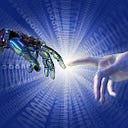Mathematics for Machine Learning: Linear Algebra and Calculus
Machine learning is a field of computer science that gives computers the ability to learn without being explicitly programmed. Machine learning algorithms are used to analyze data and make predictions.
The mathematical foundations of machine learning are linear algebra and calculus. Linear algebra is the study of vectors and matrices, which are used to represent data. Calculus is the study of change, which is used to analyze data over time.
Linear Algebra: Building Blocks of Machine Learning
Linear algebra is the foundation of machine learning. Linear algebra is used to represent data in vectors and matrices, and to perform operations on vectors and matrices.
Some of the most important concepts in linear algebra for machine learning include:
- Vectors: Vectors are a way of representing data points as points in space. Vectors can be used to represent data points in space. For example, a vector could represent the height, weight, and age of a person.
For example, in a 2D space, a vector might be represented as:
v = [3, -2]
In a 3D space, a vector might be represented as:
u = [1, 0, -4]
- Understanding vectors (quantities with magnitude and direction) and matrices (collections of numbers arranged in rows and columns).
- How they represent data in ML and perform transformations.
2. Matrices: Matrices are a way of representing relationships between data points. Matrices can be used to represent relationships between data points. For example, a matrix could represent the correlation between the height, weight, and age of a person.
Here’s an example of a 2x3 matrix:
A = | 2 1 0 |
| 3 -1 2 |- Scalar multiplication, matrix addition, and matrix multiplication.
- The role of dot products and cross products in calculations.
3. Linear transformations: Linear transformations are a way of changing the representation of data. Linear transformations are important for machine learning because they can be used to change the representation of data. For example, a linear transformation could be used to scale the height and weight of a person so that they are both on the same scale.
- Solving linear equations using matrices.
- Understanding systems of linear equations and their applications.
4. Eigenvalues and eigenvectors: Eigenvalues and eigenvectors are important concepts for understanding how linear transformations work. Eigenvalues are the scaling factors that are applied to a vector by a linear transformation. Eigenvectors are the vectors that are scaled by the eigenvalues.
- Defining eigenvalues and eigenvectors.
- How they relate to dimensionality reduction techniques like Principal Component Analysis (PCA).
Calculus: The Language of Change
Calculus is also an important foundation for machine learning. Calculus is used to analyze data over time, and to optimize machine learning algorithms.
Some of the most important concepts in calculus for machine learning include:
- Limits and Continuity: Limits are used to understand the behavior of functions as the input approaches a certain value. Limits are important for machine learning because they can be used to understand the behavior of functions as the input changes. For example, the limit of a function as the input approaches infinity can be used to understand how the function grows as the input gets larger and larger.
- Exploring the foundational concept of limits and how they define continuity.
- The role of continuity in differentiating functions.
2. Differentiation: Differentiation is used to find the slope of a function, which is important for understanding how functions change over time. The slope of a function tells you how much the function changes as the input changes. Differentiation is important for machine learning because it can be used to understand how functions change over time. For example, the derivative of a function can be used to find the rate of change of the function.
- Introducing derivatives as rates of change.
- Calculating derivatives using rules like the chain rule and product rule.
- Gradients and their significance in optimization algorithms.
- Tangent lines and local extrema in functions.
3. Integration: Integration is used to find the area under a curve, which is important for understanding how much data is available to a machine learning algorithm.
- Understanding integration as finding the area under a curve.
- Definite and indefinite integrals.
4. Multivariable Calculus:
- Extending calculus to functions of multiple variables.
- Gradient, divergence, and curl — key concepts in vector calculus.
Here are some resources that you can use to learn more about linear algebra and calculus for machine learning:
- Linear Algebra for Machine Learning: This book by Michael Nielsen is a great introduction to linear algebra for machine learning.
- Calculus for Machine Learning: This book by Kevin P. Murphy is a great introduction to calculus for machine learning.
- Machine Learning: A Probabilistic Perspective: This book by Kevin P. Murphy is a comprehensive introduction to machine learning that covers the mathematical foundations in detail.
- The Elements of Statistical Learning: This book by Trevor Hastie, Robert Tibshirani, and Jerome Friedman is a classic text on statistical learning that covers the mathematical foundations in detail.
- Mathematics for Machine Learning: This online course by Stanford University covers the mathematical foundations of machine learning in detail.
Mastering linear algebra and calculus is essential for grasping the inner workings of machine learning algorithms. From representing data to optimizing models, these mathematical concepts underpin the entire ML landscape. By familiarizing yourself with vectors, matrices, derivatives, integrals, and more, you’ll equip yourself with the tools to navigate complex ML challenges and innovate in this exciting field. So, let’s take a deep dive into all these concepts every day, as they shape the foundation of our journey through machine learning.
